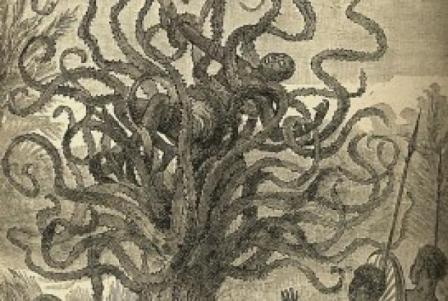
Man-eating tree can refer to any of various legendary or cryptid carnivorous plants that are large enough to kill and consume a person or other large animal. In actuality, the carnivorous plant with the largest known traps is probably Nepenthes rajah, which produces pitchers up to 38 cm (15 in) tall with a volume of up to 3.5 litres . This species may rarely trap small mammals.
The earliest well known report of a man-eating tree originated as a literary fabrication written by Edmund Spencer for the New York World. Spencer's article first appeared in the daily edition of the New York World on 26 April 1874, and appeared again in the weekly edition of the newspaper two days later. In the article, a letter was published by a purported German explorer named "Karl Liche" who provided a report of encountering a sacrifice performed by the "Mkodo tribe" of Madagascar.
The tree was given further publicity by Madagascar, Land of the Man-eating Tree, a book by Chase Osborn, who had been a Governor of Michigan. Osborn claimed that both the tribes and missionaries on Madagascar knew about the hideous tree, and also repeated the above Liche account.

Known man eating trees
The Madagascar tree

The Nubian tree
This awful plant, that rears its splendid death-shade in the central solitude of a Nubian fern forest, sickens by its unwholesome humours all vegetation from its immediate vicinity, and feeds upon the wild beasts that, in the terror of the chase, or the heat of noon, seek the thick shelter of its boughs.

The Ya-te-veo
In J. W. Buel's Sea and Land (1887), the Ya-te-veo ("I-see-you") plant is described as being native to Africa and Central America, and having "stems" that resemble "many huge serpents in an angry discussion, occasionally darting from side to side as if striking at an imaginary foe," while attempting to consume humans.

The Vampire Vine
This plant had the capability to drain the blood of any living thing which comes within its death-dealing touch

Why are some plants Meat-Eaters?

